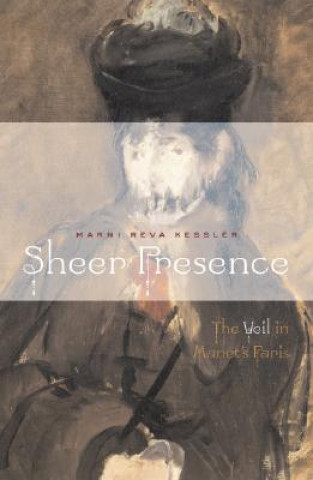
Kód: 04729959
Sheer Presence
Autor Marni Reva Kessler
Tamar's instrument of seduction in the Hebrew Bible, Penelope's shroud in Homer's Odyssey, accessory of brides as well as widows, and hallmark of the religious and the wealthy, the veil has historically been an intriguing signifie ... celý popis
- Jazyk:
 Angličtina
Angličtina - Väzba: Brožovaná
- Počet strán: 248
Nakladateľ: University of Minnesota Press, 2006
- Viac informácií o knihe

Mohlo by sa vám tiež páčiť
-

Woman in Business
24.12 € -

Tramp Abroad
20.83 € -14 % -

Rock Garden in the South
34.90 € -

Regulating Older Drivers
22.78 € -

Tempests and Romantic Visionaries
45.99 € -

Periplum and other poems
18.68 € -

Cairo
43.94 €
Darujte túto knihu ešte dnes
- Objednajte knihu a vyberte Zaslať ako darček.
- Obratom obdržíte darovací poukaz na knihu, ktorý môžete ihneď odovzdať obdarovanému.
- Knihu zašleme na adresu obdarovaného, o nič sa nestaráte.
Viac informácií o knihe Sheer Presence
Nákupom získate 98 bodov
 Anotácia knihy
Anotácia knihy
Tamar's instrument of seduction in the Hebrew Bible, Penelope's shroud in Homer's Odyssey, accessory of brides as well as widows, and hallmark of the religious and the wealthy, the veil has historically been an intriguing signifier. Initially donned in France for liturgical purposes and later for masked balls and as a sun- and windscreen at the seashore, face-covering veils were adopted for fashionable urban use during the reign of Napoleon III. In Sheer Presence, Marni Reva Kessler demonstrates how this ubiquitous garment and its visual representations knot together many of the precepts of Parisian life. Considering the period from the beginning of Napoleon III's rule in 1852 to 1889, when the Paris Universal Exhibition displayed veiled North African Muslims and other indigenous colonial peoples, Kessler deftly connects the increased presence of the veil on the streets and on canvas to Haussmann's massive renovation of Paris. The fashion of veil wearing, she argues, was imbricated with broader concerns: fears of dust and disease fueled by Haussmannization and class mixing on the city streets, changes in ideals of youth and beauty, attempts to increase popular support for imperialism, and the development of modernist art practices. A veil was protection for the proper woman from the vices associated with the modern city, preserving--at least on the surface--her femininity and class superiority. Kessler explores these themes with close readings of paintings by Gustave Caillebotte, Edgar Degas, and Edouard Manet--including Manet's perplexing portraits of artist Berthe Morisot--as well as photographs, images from the popular press, engravings, lithographs, and academic paintings. She alsomines French fashion journals, etiquette books, novels, and medical publications for clues to the veil's complex meanings during the period. Positioning the veil directly at the intersection of feminist, formalist, and social art history, Kessler offers a fresh perspective
 Parametre knihy
Parametre knihy
Zaradenie knihy Knihy po anglicky Society & social sciences Society & culture: general Cultural studies
39.73 €
- Celý názov: Sheer Presence
- Podnázov: The Veil in Manet's Paris
- Autor: Marni Reva Kessler
- Jazyk:
 Angličtina
Angličtina - Väzba: Brožovaná
- Počet strán: 248
- EAN: 9780816647828
- ISBN: 0816647828
- ID: 04729959
- Nakladateľ: University of Minnesota Press
- Hmotnosť: 399 g
- Rozmery: 229 × 150 × 14 mm
- Dátum vydania: 11. December 2006
Obľúbené z iného súdka
-

All About Love
12.82 € -19 % -

Symbol Sourcebook - An Authoritative Guide to International Graphic Symbols
62.93 € -

Sapiens
12.21 € -

Ghosts of My Life
15.49 € -24 % -

Esoteric Hollywood:: Sex, Cults and Symbols in Film
18.68 € -12 % -

Origins and History of Consciousness
21.96 € -16 % -

Pimpology
15.08 € -22 % -

Origin of the Family, Private Property and the State
14.67 € -20 % -

Notes on Camp
3.58 € -24 % -

How to Invent Everything
24.53 € -22 % -

Self-Made Man
11.69 € -19 % -

Cosmos and Psyche
18.57 € -21 % -

Homo Ludens
12.82 € -

Gilmore Girls: Stars Hollow Light-Up Sign
13.95 € -

Gastrophysics
11.08 € -23 % -

Money
6.87 € -23 % -

The Conquest of Bread
11.18 € -23 % -

Psychology of Harry Potter
18.37 € -5 % -

Cannabis Breeder's Bible
18.99 € -18 % -

Japanese Tattoos
15.60 € -19 % -

Deluxe
12.31 € -23 % -

Philosophical Enquiry into the Origin of our Ideas of the Sublime and the Beautiful
9.13 € -24 % -

Telling Lies
17.03 € -11 % -

The Tipping Point
10.98 € -24 % -

Poor but Sexy - Culture Clashes in Europe East and West
19.60 € -15 % -

Energy Flash
22.07 € -23 % -

Postmodernism, Or, the Cultural Logic of Late Capitalism
32.85 € -

Ordinary Affects
28.43 € -9 % -

Encyclopedia Gothica
22.07 € -

Communion
12.31 € -23 % -

Studio 54
88.50 € -8 % -

Field Guide To Getting Lost
9.74 € -19 % -

Neon Genesis Evangelion: TV Animation Production Art Collection
39.62 € -3 % -

Skateboarding and the City
38.49 € -17 % -

Seinfeldia
11.18 € -23 % -

Marketing Fashion, Second edition
35.62 € -14 % -

642 Things to Write About Me
17.65 € -3 % -

Balenciaga
33.46 € -12 % -

Life Sciences in Eighteenth-Century French Thought
174.85 € -

Tourists of History
43.22 € -

Turn On, Tune In, Drop Out
14.88 € -19 % -

Scientific Outlook
20.53 € -5 % -

Storytelling in Video Games
63.75 € -

Full English
20.01 € -13 % -

Folk Opposition
15.49 € -10 % -

Varieties of British Political Thought, 1500-1800
59.24 € -

Carl Barks
43.11 € -

Every Book Its Reader
16.62 € -4 % -

Pihkal
27.82 € -18 %
Osobný odber Bratislava a 2642 dalších
Copyright ©2008-24 najlacnejsie-knihy.sk Všetky práva vyhradenéSúkromieCookies



 21 miliónov titulov
21 miliónov titulov Vrátenie do mesiaca
Vrátenie do mesiaca 02/210 210 99 (8-15.30h)
02/210 210 99 (8-15.30h)